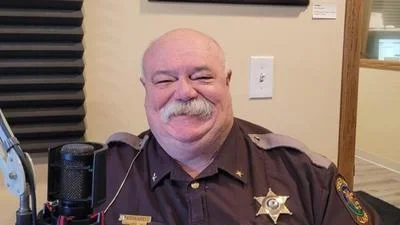Monmouth College issued the following announcement on July 20
A select group of Monmouth College students had that notion reinforced through the school’s Doc Kieft Summer Research Program. But they also became much more aware of many of the unsolved problems in the world and how the research they’re conducting can unlock a path to potential solutions.
“It’s like I added 2 and 2 and got 7,” said Isaac Asplund ’22 of Oneida, Illinois, explaining an inconsistency in his research, which was titled “Formation of Substituted Nitrogen-Nitrogen Bonds.”
Asplund made his comment on the day that the program’s 12 participants each made 15-minute presentations on what they researched over the course of the intensive eight-week research program. The program was created after the College received an estate gift of $2.3 million from beloved Monmouth chemistry professor Richard “Doc” Kieft. It gives students excellent preparation for graduate or professional school.
“None of us knew what was going to happen with the new science building, but Doc did. He lives within these walls.” – Brad Sturgeon
Chemistry professor Brad Sturgeon, who was a colleague of Kieft, explained that the late professor believed in the importance of attracting strong science students to Monmouth through scholarships; of providing them robust research opportunities once they matriculated; and of facilitating their travel to regional and national conferences where they could present their research.
“Every day, I get here and look around, and I see Doc,” said Sturgeon, referring to the College’s Center for Science and Business, which was built after Kieft’s 2009 death but not without his input. “He’d come back from a meeting and say, ‘I got us another lab’ or ‘The labs are 33% percent bigger than originally planned.’ None of us knew what was going to happen with the new science building, but Doc did. He lives within these walls.”
Exploring the unknown
Riley Bigham ’23 of O’Fallon, Illinois, expressed the vast unknown in science today when she discussed her project, which dealt with microbiomes.
“A microbiome is a community of microorganisms living in an ecosystem or organism,” she said. “Less than 1% of microorganisms have been discovered.”
That includes microorganisms in what she called “the human microbiome, the forgotten organ.” Making strides in the discovery of microorganisms could lead to advancements in such areas as digestive health, reducing inflammation and weight control.
But Oradiegwu and Sellers found that science is, indeed, hard, both in terms of the data collection at a “dingy, smelly, wet cave” in the Ozarks, and in terms of not finding the right bats. None of the 300 samples of guano – the droppings of bats made famous by Jim Carrey in his role in Ace Ventura, Pet Detective – had coronavirus present or, for that matter, another RNA (ribonucleic) virus, rabies.
That led to an interesting conclusion about the gray bats they researched.
“This experience also showed me that even if things do not work at first you should not give up and try whatever you can to try to come up with a solution.” – Jonathan Oradiegwu
“They’re basically practicing social distancing,” said Oradiegwu. “They’re very selective in the caves they roost in, and they don’t mix with other species.”
Oradiegwu indicated that the process was more valuable than specific results.
“This summer gave me the skills and tools I need necessary to better understand my classes here at Monmouth – tools such as purifying DNA, taking RNA and transforming it to DNA using reverse transcriptase, and other molecular biology skills,” he said. “This experience also showed me that even if things do not work at first you should not give up and try whatever you can to try to come up with a solution.”
Both Oradiegwu and Sellers are planning to continue their education beyond Monmouth.
“I have plans to go to medical school after I graduate, and this experience made me a better candidate for medical school,” he said.
Said Sellers: “I’m planning to further my education in microbiology, and I was lucky enough to get to work this summer with our school’s microbiologist, Dr. Godde. This experience has solidified my decision to further my education in this topic. I was able to work with many machines and followed many protocols that will be similar to what I will do in the future.”
Ongoing projects
Several of the Kieft students picked up research started by earlier Monmouth students, including Brendan Guenther ’22 of Pekin, Illinois, whose project title was “Investigating the Surface Molecular Interactions of Cannabidiol with Phospholipids via the Langmuir Monolayer Technique.”
“I was drawn to this project because I liked the beneficial wound-healing effects,” he said. “CBD has a variety of health benefits, from helping with anxiety and depression to reducing pain and inflammation.”
“Science is a process and not just a three-hour lab that works perfectly. The time in the summer allows for this.” – Audra Goach
At the conclusion of her presentation of a project centering on the organic compound vanillin, Talia Long ’22 of Troy, Missouri, said, “I’ll need to continue fine-tuning the amount of (the reagent) IPTG to isolate the protein.”
It takes a summer, if not longer, to reach such conclusions, said Monmouth chemistry professor Audra Goach.
“The students work eight hours a day and some days are extremely successful while others are not,” she said. “However, these days of unsuccessful results are actually results that lead to changes they need to make in their experiments. Science is a process and not just a three-hour lab that works perfectly. The time in the summer allows for this.”
Goach shows students her doctoral thesis, which she said “is remarkably smaller than what they would think it would be for six years of work. That’s because of the time spent redoing data, confirming data and adjusting parameters. … All of this research time is invaluable to a student’s education. Doc Kieft knew how important this experience was for our students and we are grateful for him every day.”
Other students who presented their research were Amanda Dybal ’22 of Apex, North Carolina, Gabriela Peterson ’22 of Southwick, Massachusetts, Sreya Roy ’22 of Kolkata, India, Matt Simonson ’22 of Monmouth, Cal Bigham ’22 of Aledo, Illinois, and Shay Hafner ’22 of Sterling, Illinois. The latter two students worked under the direction of Robert Utterback from the College’s Department of Mathematics, Statistics and Computer Science, marking the first time that department’s students participated in the Kieft program.
“This experience has given me the opportunity to develop skills that can be used whenever I go after Monmouth,” said Bigham. “Currently, I would like to go to graduate school for computer science, and this opportunity showed me how that experience might be.”
Original source can be found here.





 Alerts Sign-up
Alerts Sign-up